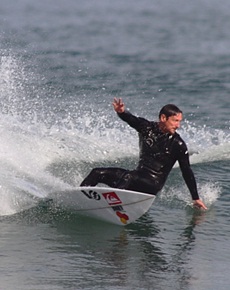Surf science

Top surfers have a reputation for being laid-back beachgoers who spend most of their time lying on the sand.
New research from AUT’s Sports Performance Research Institute New Zealand (SPRINZ) paints a very different picture of the physical demands required of surfers at the top level.
World-class surfers need to have good fitness and the right combination of strength, power and endurance. Surfing, it seems, is more than just hanging around waiting for the perfect wave.
The research, which came out of Oliver Farley’s Masters thesis, is among the first of its kind in the world. The findings have been published around the world in journals, surfing websites and the general media including a piece in the New York Times.
PhD scholarship to work with top Aussie surfers
Farley has now been offered a doctoral scholarship out of Perth’s Edith Cowan University with Surfing Australia High Performance Centre and Edith Cowan University in Casurina Beach, Queensland He will have a series of roles including strength and conditioning coach and physiologist of some of the world’s top up and coming surfers. He has turned what was a hobby he is passionate about, into a career.
The genesis of the research was a conversation Oliver had with SPRINZ associate director Dr Nigel Harris while he was doing his Postgraduate Diploma in Sport and Exercise.
“I was just finishing my quantitative research proposal assignment on surfing, and when I approached Nigel about the idea for a thesis the following year we found that there wasn’t much research done on this subject. Nigel was great.”
Farley and Dr Harris, who was one of Farley’s supervisors, wanted to understand the physical intensity required of elite surfers, the power required to paddle through the surf and how far they travelled in during competition.
Farley enlisted some of the country’s top surfers, including Maz Quinn, who were competing at national level events to be his subjects. He modified a kayak ergometer machine in his garage to measure the power outputs and peak oxygen uptakes. To measure the intensity and distance covered he fit the surfers out with GPS and heart rate monitors while videoing them.
“They were a bit reluctant at first because they (the GPS monitors) were a bit bulky. But after seeing the first round of results they, being competitive guys, wanted to know how they were going against their mates.”
Unexpected results
Farley says some of the findings were surprising.
“We thought that their heart rate would peak when they were paddling to catch the wave but it turned out to be when they finished the wave and started the paddle back out. That may be due to the adrenaline release,” he said.
The research also revealed that heart rates went up to 190 beats per minute and were above 120 for over 80% of the time. “That told us that paddling around waiting for a wave was more intense an activity than we thought.”
Surfers were paddling on average 950 metres in each heat waiting for the right wave.
While these findings indicate surfers need a high level of aerobic fitness, the power tests on the erg machine were also instructive.
The best surfers had the best power output readings. Farley concludes two things from this: If they have better power they can catch more waves in a heat and in those waves they do catch, they are not as fatigued and can therefore perform at the best of their ability.
This research and further work Farley does with Surfing Australia will be used to design strength and conditioning protocols for Australia’s up-and-coming surfers.
Like all sport at the elite level, those that get the best use of science will have an advantage. A competitive sport has just got that much more competitive.